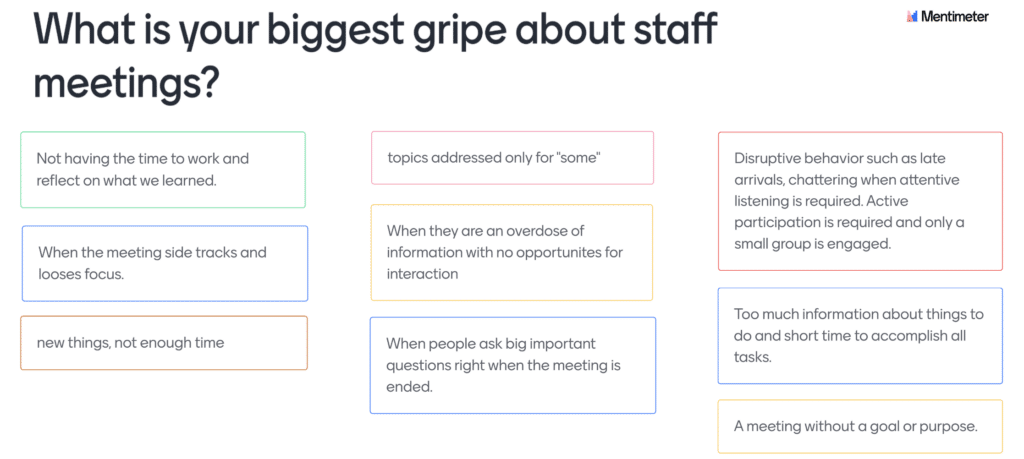
Is Your Class Like a Staff Meeting? – Dr. Catlin Tucker
Final week, I started a coaching session on universally designing blended learning by inquiring teachers to mirror on and talk about the adhering to issue. “What is your most important pet peeve about team meetings?” This question led to a vibrant and boisterous discussion! The lecturers experienced no lack of gripes about employees meetings.

The group said sitting by long-winded presentations covering far too considerably details was mind-boggling and uninteresting. They pointed out that a lot of the facts could have been delivered through e mail. The information and facts provided typically felt irrelevant to their distinct instructing assignment. They had been annoyed that meetings were regularly derailed by questions precise to a one teacher’s working experience and agreed that the similar teachers seemed to communicate at each meeting. They groaned when describing the tediousness of sitting down by means of countless inquiries because academics had been not paying out awareness during the very first explanations, demanding that administrators repeat them selves and the written content. They wished time to interact with colleagues, acquire the information and facts provided at the conferences, and act on it. The academics agreed that their time would have been much better put in somewhere else.
Just after facilitating a share out of their views and feelings about staff members conferences, I created the issue that several students have the exact same issues about their activities in school rooms. Instructors shell out too a great deal time presenting information and not more than enough time enabling learners to interact or apply what they are finding out. The details is not normally certain to their needs. They position out that the same pupils dominate discussions, inquiring and answering thoughts while the relaxation of the course is silent. They are usually bored in courses due to the fact they are not actively engaged in the mastering.
So, how do we keep away from operating our lessons like a staff members assembly?
#1 Be strategic about what you current in person.

When coaching lecturers, I inspire them to check with by themselves, “Do I strategy to say the similar point, the very same way to all learners?” If the respond to is “yes,” I really encourage them to file a movie clarification or model and make it possible for students to self-speed by it. If the reply is “no,” I counsel they facilitate modest team differentiated instruction in a station rotation lesson at their teacher-led station. You will observe there is not a full team instruction choice.
The total group, teacher-led, instructor-paced strategy to instruction is rife with obstacles that make it challenging for all pupils to entry the facts introduced. College students might have auditory processing problems or attention deficit dysfunction. They could not have the background knowledge or vocabulary to comprehend the facts. The tempo at which the information and facts is presented may be also rapidly or too slow. They may well simply just be daydreaming, distracted, or absent. Numerous of these boundaries can be removed when we use other varieties of media to transfer information and facts. Can the information or instruction be delivered through a electronic text, video clip, or podcast? If students study an on-line text to purchase info, they can grow the dimensions of the text, look up unfamiliar words and phrases, or translate components of the textual content if English isn’t their very first language. If they are watching a online video or listening to a podcast, they can pause, rewind, and rewatch or relisten to sections.
If our goal is to make mastering obtainable, inclusive, equitable, and engaging, we need to be strategic about how we use our course time. Technology transfers information exceptionally very well, so let’s leverage that to cost-free ourselves from the front of the home and encourage learners to have interaction actively in learning actions.
#2 Prioritize Conversation and Application in Course

Like lecturers in a personnel assembly, students crave alternatives to engage with one particular yet another. Discovering is, in aspect, a social system. Pupils require time to interact with each and every other in class. They should focus on and collaborate with various companions to create a deep being familiar with of complex ideas. They are also extra likely to correctly hone distinct capabilities if they can entry peer and trainer assist as they practice and implement. The key is to style lessons that placement the learners, not the instructor, at the center of the knowledge.
#3 Differentiate the Experience

It is tempting to tune out of a team meeting when it feels like the info isn’t related. I have despatched my reasonable share of e-mail and textual content messages for the duration of staff members conferences when I was bored and disengaged. The exact same issue takes place in lessons when instructors present info or assign tasks that are not inside of their students’ zones of chance. We have to accumulate and use formative evaluation data to differentiate lessons to be certain we are conference students exactly where they are at in conditions of their desires, abilities, skills, and language proficiencies. With no evaluating prior information and often checking for understanding, it is virtually unachievable to properly differentiate the understanding expertise.
From Entire Group Lessons to Blended Finding out Models
Using blended understanding products is an successful way to shift control around the mastering expertise from lecturers to students. Blended finding out is the mix of energetic, engaged finding out on-line with energetic, engaged understanding offline to give learners more command about the time, position, rate, and path of their understanding. These products make it possible for academics to style scholar-centered discovering ordeals that prioritize pupil autonomy and agency, differentiate successfully working with informal and official facts, and give college students more command about the rate and route of their studying to take out obstacles.
All of these pillars of high-good quality blended learning–student company, differentiation, and manage above tempo and path–can ensure our courses do not sense like pupils are sitting via a staff meeting. As a substitute, these styles inspire learners to be active brokers in the classroom included in each and every component of the lesson.
| Station Rotation Product | The station rotation product is composed of a collection of studying functions that pupils rotate as a result of, which includes a trainer-led station, an on line station, and an offline station.
This design frees the trainer to get the job done with tiny groups, differentiating instruction, versions, and help whilst producing alternatives for modest teams of learners to get the job done together to go over, look into, collaborate, observe, and produce. |
| Full Group Rotation Model | The total group rotation model rotates the total course among online and offline learning functions. The total team rotation encourages academics to pair each and every finding out action with the most effective finding out landscape for that activity–online or offline.
This model allows the teacher to guideline whole team modeling sessions or existing mini-classes even though also freeing them to do the job with men and women, pairs, or smaller teams through the on the internet understanding actions. On-line mastering routines can also be differentiated and individualized for learners at diverse stages. |
|
Flipped Classroom Design |
The flipped classroom design inverts the traditional solution to instruction and software. Academics file video clip instruction, and learners self-tempo via the recordings, pausing, rewinding, and rewatching as wanted.
Class time is utilised to encourage learners to observe and use with trainer and peer assistance. |
| Playlist or Personal Rotation Design | The playlist product is a sequence of discovering functions built to go pupils toward a very clear objective or wished-for end result. A playlist can be employed to educate a strategy, method, talent, method, or walk college students by way of the components of a multi-phase effectiveness process or undertaking. College students regulate the pace of their development by a playlist with periodic examine-ins or conferencing sessions with the trainer.
This product encourages the trainer to target on giving individualized support as learners progress by means of the playlist. |
Workers conferences are a section of just about every educator’s lifetime, but they are so monotonous to sit through simply because they often fall short to sense pertinent, partaking, or a terrific use of our cherished time. Pupils could sense the very same way in lecture rooms exactly where the lessons are trainer-centered and teacher-paced. They are considerably extra possible to lean into the lesson if they have meaningful alternatives, the information is presented at a degree they can obtain, and they have chances to interact with each individual other. Checking out other models made to mix on-line and offline mastering present pathways to offering learners with a significantly much more dynamic, differentiated, and equitable mastering expertise they enjoy.
